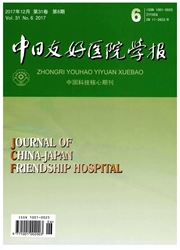

 中文摘要:
中文摘要:
目的:检测抗PUF60抗体在中国特发性炎性肌病(IIM)患者中的阳性率,并分析其相关的临床意义。方法:本研究共纳入388例IIM患者[275例皮肌炎(DM)、76例多发性肌炎(PM)及37例肌炎-重叠综合征]和167例健康对照(HCs)。酶联免疫吸附测定(ELISA)测定入组患者及健康对照的抗体滴度,并联合免疫印迹实验验证ELISA结果的可靠性。结果:抗PUF60抗体可见于各IIM亚组,阳性率均高于健康对照组,包括11.3%(P〈0.01)的DM、7.9%(P〈0.05)的PM和21.6%(P〈0.01)的肌炎重叠综合征患者。在经典DM中,该抗体常见于肌炎抗体阴性的患者(P〈0.05),并与技工手发生相关;且该抗体在无肌病性皮肌炎中阳性率较高,与皮肤溃疡的发生相关。结论:抗PUF60抗体在中国肌炎患者中普遍存在,且不同亚型的临床相关性各异,提示抗PUF60抗体或其靶抗原PUF60可能在不同亚型的肌炎中参与了不同的致病过程。
 英文摘要:
英文摘要:
Objective:To detect the existence and to analyze the clinical significance of anti-PUF60 antibody in Chinese patients with idiopathic inflammatory myopathy(IIM).Methods:This study involved 388 IIM patients [including 275 patients with dermatomyositis (DM),76 with polymyositis (PM)and 37 with myositis overlap syndrome] and 167 healthy controls(HCs).An ELISA was developed to detect serum anti-PUF60 antibody and immunoblotting analyses were performed to validate the ELISA results.Results:Anti-PUF60 antibody presented in 11.3% DM patients,7.9% PM patients and 21.6% patients with myositis overlap syndrome,and the antibody positive rates of them were significantly higher than HCs (P〈O.05,P〈0.01).Classical DM patients with anti- PUF60 antibody had lower prevalence of currently known myositis antibodies(P〈0.OS)and higher prevalence of mechanic's hands.While the prevalence of anti-PUF60 antibody was particularly higher in the CADM subgroup (29%)and associated with the incidence of skin ulcer.Conclusion:Anti-PUF60 antibody can be detected in Chinese patients with IIM,and it is associated with distinct clinical features in different rheumatic diseases.This finding indicates that anti-PUF60 antibody is associated with different pathogenesis processes in different IIM subgroups.
 同期刊论文项目
同期刊论文项目
 同项目期刊论文
同项目期刊论文
 期刊信息
期刊信息
